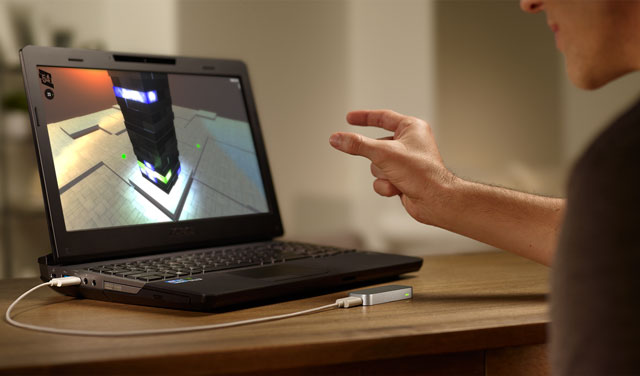
More than a decade after sci-fi blockbuster Minority Report introduced us to gesture-based computer interfaces, the Leap Motion Controller made its retail debut last year to much fanfare.
Now, a new, more advanced version of Leap Motion’s gesture control software is in the works. TechCentral played around with version two of the software, which is still in beta testing.
The device, which looks like a large USB dongle, houses two infrared cameras and three infrared LEDs, and it’s able to sense movement in a space about 1m above it.
The technology, developed by Leap Motion co-founder David Holz, is designed to track the movement of two hands over the controller. The company says it offers accuracy of up to a hundredth of a millimeter.
Installation and setup is straightforward and requires one free USB port and a driver to be downloaded from the company’s website.
The box includes two different lengths of USB cable so the controller can be connected to a desktop PC or a notebook computer.
Once connected to a PC (or Mac), the controller allows you to interact with your computer using special applications that can be installed from an app store called Airspace. Depending on the app — be it a game, 3D modelling or interface control — you are able to hover your hands over the device and interact with whatever is on your screen.
The app store contains just over 200 free and paid applications which range in price from $0,99 to $9,99. Unfortunately, not all paid apps come with a trial version, and it is often a hit or miss affair trying to get the best app for the job at hand.
There is a good selection of apps in Airspace and one of the first you should install is AirInput ($4,99), an app for both Windows and Apple iOS devices that provides the interface required to control your computer using only hand gestures. The app store also contains a number of plug-ins for software such as Autodesk Maya 2014, Windows Media Player and even Internet Explorer. However, support is needed for a broader range of software.
Leap Motion has made the application programming interface available for free to encourage people to develop software for the system.
At the time of writing, Leap Motion had also made available a new software development kit called V2 Skeletal Tracking Developer Beta. This new version of the Leap Motion software provides more detailed tracking and introduces a cool but slightly creepy feature that allows the device to mimic the joints in your hands (see video above).
The new version of the software also introduces pinch-and-grab controls that allow for a far richer experience than the capabilities of the current software version.
While we had loads of fun “experimenting” with a variety of games and modelling applications, the true usability of the Leap Motion Controller seems somewhat limited.
The technology has numerous useful applications within the world of technology, but we cannot help but think that it is still too early for this hardware to replace the mouse and keyboard as the primary interface device for your computer.
The problem, for now, is still in the implementation of the software. Although there are some great apps in Airspace, it feels like the technology is still trying to find its true purpose.
Hovering your hands in the air while trying to control your computer’s interface is novel. But it’s also often frustrating and we found that switching to a keyboard and mouse was the best way to get things done quickly.
For educational purposes, the Leap Motion Controller may offer a better reason to make use of the technology, though more such software is needed in Airspace, specifically focusing on biology and science.
The Leap Motion Controller retails for R1 299. — © 2014 NewsCentral Media

